Fujian, with its blend of rich history, diverse culture, and natural beauty, is a fantastic province to explore by train. Aside from the scenic landscapes, Fujian’s train routes offer travelers a chance to experience the province’s cultural and historical significance. Here’s another perspective on traveling by train in Fujian—focusing on the cultural and historical attractions that are easily accessible via rail.
1. Trains as a Gateway to Fujian's History
Fujian is a province steeped in history, from its ancient temples to its vibrant Maritime Silk Road heritage. Many of these cultural landmarks can be conveniently accessed by train, making rail travel a great way to delve into Fujian’s past.
● Quanzhou: Once a major port city and a key hub on the Maritime Silk Road, Quanzhou is an essential stop for history enthusiasts. The city is only a short 1-1.5-hour train ride from Xiamen. As you travel, you will pass through picturesque countryside and arrive in a city famous for its ancient temples, mosques, and relics from the Yuan Dynasty. The Kaiyuan Temple, ** Qingjing Mosque**, and Chenghuang Temple are key historical sites in Quanzhou that offer a glimpse into the city’s rich past.
● Fuzhou: The provincial capital, Fuzhou, is an excellent base for exploring Fujian’s historical sites. Fuzhou’s Three Lanes and Seven Alleys, a maze of ancient streets, is a perfect representation of the region’s architectural heritage. Trains from Xiamen to Fuzhou take about 3 hours, offering travelers an easy access route to explore this cultural area. Fuzhou's Drum Tower, dating back to the Tang Dynasty, and the Fujian Provincial Museum are must-see spots for anyone interested in the region’s history.
● Sanming: For travelers interested in Fujian’s traditional Hakka culture, the city of Sanming is a great destination. The train journey from Fuzhou to Sanming takes about 3 hours and offers travelers the opportunity to explore the Hakka Tulou (traditional earthen buildings), which are recognized as UNESCO World Heritage Sites. These distinctive structures, often round or square in shape, represent centuries of Chinese history and architectural prowess.
2. Trains Linking Nature with History
In Fujian, the combination of natural beauty and cultural heritage makes train travel even more captivating. The train routes to certain destinations allow travelers to experience both.
● Wuyi Mountain: As a UNESCO World Heritage Site, Wuyi Mountain is a must-visit for nature and history lovers alike. The Fuzhou to Wuyi Mountain route, which takes about 4-5 hours by train, offers travelers access to a region known for both its ancient tea culture and spectacular landscapes. Wuyi Mountain is rich in both natural and cultural heritage—visitors can explore ancient temples, enjoy a traditional tea ceremony, and hike in the mist-covered mountains that have stood for centuries. The mountain’s dramatic peaks and winding rivers make for a breathtaking journey by train.
● Xiamen's Gulangyu Island: A short train ride from Xiamen Railway Station to the ferry terminal can take you to Gulangyu Island, which is famed for its colonial-era architecture and peaceful ambiance. While on the island, visitors can explore the Gulangyu Piano Museum, learn about the island’s rich history through its European-style villas, and take in the stunning sea views. The combination of historical buildings and tropical landscapes makes Gulangyu an unforgettable cultural experience.
3. Experiencing Local Culture and Traditions
Traveling by train also offers the opportunity to experience Fujian's diverse ethnic groups and local traditions, many of which are accessible by train. For instance, the Minnan culture in Xiamen is a blend of indigenous practices and influences from Southeast Asia, which you can explore through traditional architecture, opera, and local festivals. On the train to Kaili in southern Guizhou, you’ll see how the region’s ethnic minority cultures, such as the Hakka and Miao peoples, have influenced the local way of life.
Trains in Fujian also pass through regions where local food traditions thrive. You can sample Fujian's famous dishes such as Buddha Jumps Over the Wall, Fujian Fried Rice, and Lychee Pork, which reflect the province’s long history of culinary innovation. Many regional specialties can be found at railway station food courts, local markets, or street vendors along your route.
4. Easy Access to Traditional Villages and Ethnic Communities
One of the most interesting aspects of train travel in Fujian is the accessibility to traditional villages and ethnic communities, which offer a deeper insight into the province’s cultural fabric. For example:
● Fujian Tulou: Train journeys to rural areas such as Sanming or Nanjing take you to the Fujian Tulou. These ancient, large, circular, and fortified structures have been home to the Hakka people for centuries. They offer an exceptional glimpse into the rural lifestyle and traditional customs of one of China’s most intriguing ethnic communities.
● Traditional Crafts: On your train journey, you may come across artisans showcasing traditional crafts like Banyan wood carving and Fujian tea. Trains heading towards Fuzhou or Xiamen will offer access to these local crafts, where visitors can interact with artisans and learn about the history of their craft.
Conclusion
Traveling by train in Fujian offers much more than just a way to get from point A to point B. It provides an opportunity to delve deeper into the region’s rich cultural heritage, explore its historic landmarks, and witness the beautiful landscapes that have inspired poets, artists, and travelers for centuries. Whether you're visiting ancient temples in Quanzhou, exploring the tea culture of Wuyi Mountain, or experiencing the unique traditions of the Hakka people, traveling by train in Fujian is an enriching experience for both culture and history enthusiasts.
Related Posts
Create Your Customized Trip
Take about 2 minutes to fill the form to tell us how you like to travel, and get a reply within 1 working day.









